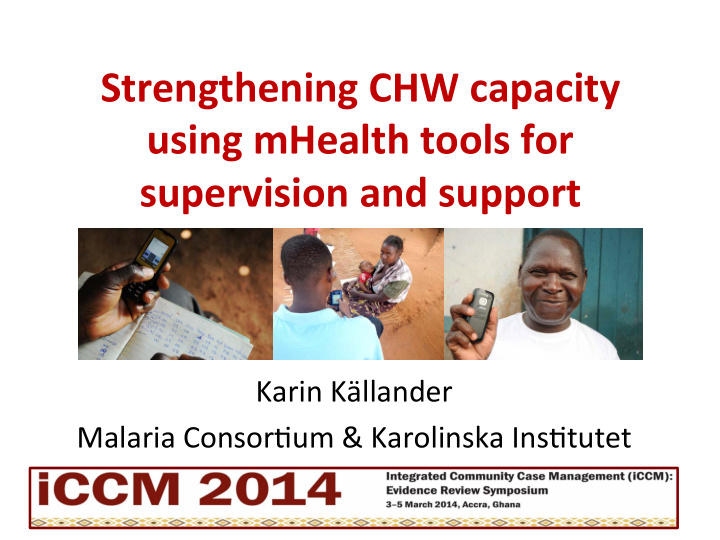



Strengthening ¡CHW ¡capacity ¡ using ¡mHealth ¡tools ¡for ¡ supervision ¡and ¡support ¡ Karin ¡Källander ¡ Malaria ¡Consor/um ¡& ¡Karolinska ¡Ins/tutet ¡
Content ¡of ¡the ¡presenta9on ¡ • What are some of the challenges the community health workers face in providing high quality services • inSCALE project in Uganda and Mozambique Ø Intervention design using a holistic approach Ø Preliminary results Ø Lessons learned • The future – health system strengthening and possible expansion
Challenges ¡to ¡appropriate ¡ treatment ¡of ¡sick ¡children ¡ ¡ Community based health programmes are being scaled up, but for sustained impact there is need to address: • Motivation among CHWs • Performance of CHWs • Availability of data showing the e ff ect of the programme to all policy makers in the health system • Availability of data to monitor case load and enable commodity availability
Addressing ¡the ¡ challenges ¡ • inSCALE aims to identify best practices and innovative solutions to main CHW programme barriers: – CHW motivation – Supportive supervision of CHWs – CHW performance Ø More appropriate treatment of sick children • Randomised controlled trial with CHWs in Uganda (VHTs) and Mozambique (APEs)
inSCALE ¡mHealth ¡innova9on ¡– ¡ Theore9cal ¡framework ¡ Closed user Alerts to Data Monthly Intervetnion components group for supervisor submission motivational supervision triggered by and SMS and peer data feedback support PROVISION OF AFFORDABLE MOBILE PHONES AND SOLAR CHARGERS motivation Drivers of Connectedness to Standing, status, Support & technical the health system identity & value supervision Increased CHW performance and motivation Increased CHW retention and appropriate treatment of sick children
Strengthening ¡the ¡ Increased recognition Ability to establish of symptoms, CHW ¡services ¡– ¡ ¡ better provider-patient improved care relationships = more inputs ¡and ¡ seeking e ff ective counselling outputs ¡ Providing CHWs with electronic tools Improved health to counsel patients and educate prevention behaviour community members
Strengthening ¡ Better More e ff ective the ¡CHW ¡ forecasting/ supervision of redistribution of services ¡– ¡ inputs ¡ CHWs commodities and ¡outputs ¡ Real time data to guide response actions Electronic tools for more CHW performance data and timely and complete case electronic tool for doing reporting competency checks
inSCALE ¡implementa9on ¡area ¡ Mozambique ¡ Control arm – 6 districts Intervention arm – 6 districts • 132 CHWs and 47 supervisors trained and provided with phones • To be evaluated after 12 months implementation
inSCALE ¡implementa9on ¡area ¡ Uganda ¡ SUDAN Kaabong Kobok Yumbe Moyo Lamwo o Kitgu Maracha m DEMOCRATIC Adjuman i Kotid Gulu o Pader REPUBLIC Arua Amur Abim CONGO u Morot o Napa Nebb Oya Lira k i m Kiryandongo Buliisa Apac Katakw Dokolo Amuri i a Nakapiripirit Amudat Masind Sorot Kumi Buked i Kapchorw i a Hoim ea a Nakasek Pallisa Sironk Kyankwanzi e o Kamuli Kaliro Kibaal Namu Luwer e Kibog - o Kyenjojo a Igang Tororo tumb a Kabarol Jinja a Busi e Bugir ALA KAMP MPAL a Mubend Mayug Mukon Kyeggegw Mityan e i e KENYA o a Kamweng a Wakiso Kases Gomb e e Butambal a Sembabul a Mpigi de Lyanton e Iband Kalung a Kiruhur u Bukomansimb a i Busheny Lweng Masak i Mbarar o a a Kalangal a Rakai Isingir Ntungam o o Kabal Kisoro e TANZANIA RWANDA 880 CHWs in 13 1,277 CHWs in 1,011 CHWs in 13 sub-counties in 13 sub-counties sub-counties in control arm in mHealth arm community arm
Cross-cutting lessons learned • Data submission and feedback was highly motivating • Communication with peers and supervisors increased: o Referral (to peers and HFs) o Medicine supply o Peer support • Solar chargers helpful in treating at night/facilitating home work for school children
“For ¡me ¡the ¡respiratory ¡/mer ¡is ¡ the ¡most ¡important ¡because ¡ the ¡caregiver ¡can ¡see ¡[the ¡ result] ¡for ¡themselves ¡and ¡it ¡is ¡ easy ¡to ¡be ¡interpreted ¡by ¡the ¡ caregivers….You ¡see ¡for ¡these ¡ pa/ents ¡who ¡come ¡with ¡cough ¡ and ¡for ¡you ¡to ¡convince ¡that ¡ person ¡that ¡he ¡or ¡she ¡does ¡not ¡ have ¡fast ¡breathing ¡is ¡not ¡easy ¡ and ¡many ¡/mes ¡they ¡go ¡back ¡ when ¡they ¡are ¡annoyed“ ¡ ¡ (VHT ¡Uganda) ¡
Cross-cutting lessons learned • Barriers – System functionality – Timely/automated data bundle activation – Patchy network coverage – Fragile equipment – Visual impairment
Early ¡inSCALE ¡results ¡-‑ ¡Mozamqiue ¡ Between August 13-February 2014: Malaria positivity rate Jun-Sept Ø 132 APEs sent 36,107 patient forms and Oct-Dec 2013 Ø Median 34 patients per month (range 0-188) Newborn ¡ Under ¡5 ¡ Over ¡5 ¡ Diagnosis for 13,922 under 5 yrs: - 9% pneumonia - 16% diarrhoea - 61% con fj rmed malaria
mHealth ¡expansion ¡to ¡strengthen ¡ health ¡system ¡ Immuniza/on ¡ Electronic ¡job ¡aids ¡for ¡ Birth ¡& ¡death ¡ registra/on ¡and ¡ other ¡condi/ons, ¡e.g. ¡ registra/on ¡and ¡audit ¡ follow-‑up ¡systems ¡ pregnant ¡women ¡ of ¡reported ¡deaths ¡ Health ¡facility ¡weekly ¡ and ¡monthly ¡reports ¡ Complete ¡commodity ¡ tracking ¡system ¡for ¡all ¡ levels ¡of ¡health ¡care ¡ Performance ¡ Improved ¡planning ¡of ¡ monitoring ¡and ¡ services ¡due ¡to ¡more ¡ incen/ves ¡ available ¡and ¡accurate ¡ informa/on ¡
Conclusions ¡ • Though the mHealth fj eld is still in its early stages, it has already begun to transform health delivery and demonstrated concrete bene fj ts • For maximum impact, mHealth solutions should be holistic; integrating multiple health system functions • Success depends on a harmonised mHealth agenda and close partnerships between multiple national stakeholders • mHealth approaches that provide solutions to key CHW challenges, such as supervision and motivation, can potentially play an important role in e ff ective iCCM implementation at scale
Thank ¡you!! ¡
Recommend
More recommend